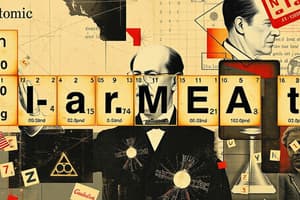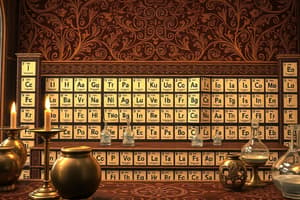Podcast
Questions and Answers
What is the Periodic Law?
What is the Periodic Law?
- The arrangement of elements based on valence electrons
- The arrangement of elements based on atomic mass
- The arrangement of elements based on electronegativity
- The arrangement of elements based on atomic number (correct)
What are the Lanthanides?
What are the Lanthanides?
- Elements with atomic numbers from 90 to 103
- Elements in group 18 of the periodic table
- Elements in group 1 of the periodic table
- Elements with atomic numbers from 58 to 71 (correct)
What defines the Actinides?
What defines the Actinides?
- Elements in group 18 of the periodic table
- Elements with atomic numbers from 58 to 71
- Elements in group 1 of the periodic table
- Elements with atomic numbers from 90 to 103 (correct)
What are the Alkali metals?
What are the Alkali metals?
Which region of the periodic table do elements with similar properties fall into?
Which region of the periodic table do elements with similar properties fall into?
What organizes the elements in order of their atomic numbers?
What organizes the elements in order of their atomic numbers?
Which group of elements is known as the Alkaline-Earth metals?
Which group of elements is known as the Alkaline-Earth metals?
What is the main characteristic of Transition Elements?
What is the main characteristic of Transition Elements?
Which group of elements do the Halogens belong to?
Which group of elements do the Halogens belong to?
What is the definition of ionization energy?
What is the definition of ionization energy?
What is the definition of cation?
What is the definition of cation?
What is the definition of electronegativity?
What is the definition of electronegativity?
What is the definition of anion?
What is the definition of anion?
What defines Atomic Radius?
What defines Atomic Radius?
What is the definition of valence electrons?
What is the definition of valence electrons?
What defines Ion?
What defines Ion?
Flashcards are hidden until you start studying
Study Notes
Periodic Law
- The Periodic Law states that the chemical properties of elements are periodic functions of their atomic numbers.
- This means that elements with similar properties appear at regular intervals in the periodic table.
Lanthanides
- The Lanthanides are a series of 15 metallic elements with atomic numbers 57 to 71.
- They are located at the bottom of the periodic table and are often grouped with the elements Scandium and Yttrium.
- They are characterized by their similar chemical properties and are often difficult to separate from each other.
Actinides
- Actinides are a series of 15 radioactive elements with atomic numbers 89 to 103.
- They are placed at the bottom of the periodic table and share similarities with the Lanthanides in their properties.
- All Actinides are radioactive and are typically found in trace amounts in nature.
Alkali Metals
- Alkali metals are a group of elements located in Group 1 (IA) of the periodic table.
- They are soft, highly reactive metals that readily lose their outermost electron to form cations with a +1 charge.
- Examples include Lithium (Li), Sodium (Na), Potassium (K), Rubidium (Rb), Cesium (Cs), and Francium (Fr).
Similar Properties
- Elements with similar properties fall into the same groups (columns) of the periodic table.
- Elements within a group have the same number of valence electrons, which are the electrons in the outermost shell.
Organization of Elements
- The periodic table organizes elements in order of their atomic numbers.
- This determines the number of protons in an atom's nucleus.
Alkaline-Earth Metals
- Alkaline-Earth metals are a group of elements located in Group 2 (IIA) of the periodic table.
- They are reactive metals that readily lose their two outermost electrons to form cations with a +2 charge.
Transition Elements
- Transition Elements are located in Groups 3 to 12 (IIIB to IIB) of the periodic table.
- They are characterized by their ability to form ions with multiple charges, contributing to their diverse chemical properties.
Halogens
- Halogens are nonmetallic elements found in Group 17 (VIIA) of the periodic table.
- They are highly reactive and have a strong tendency to gain an electron to form anions with a -1 charge.
Ionization Energy
- Ionization energy is the minimum energy required to remove an electron from a gaseous atom in its ground electronic state.
- Higher ionization energy makes it harder to remove an electron.
Cation
- A cation is a positively charged ion formed when an atom loses one or more electrons.
Electronegativity
- Electronegativity is a measure of an atom’s ability to attract electrons towards itself when forming a chemical bond.
Anion
- An anion is a negatively charged ion formed when an atom gains one or more electrons.
Atomic Radius
- Atomic radius is the distance from the nucleus of an atom to its outermost electron shell.
Valence Electrons
- Valence electrons are the electrons in the outermost shell of an atom, and are responsible for chemical bonding.
Ion
- An ion is an atom or molecule that has gained or lost one or more electrons, resulting in a net positive or negative charge.
Studying That Suits You
Use AI to generate personalized quizzes and flashcards to suit your learning preferences.




